The war in Gaza continues to make headlines and draw global attention to movements, protests, and the ongoing conflicts in the Middle East. Whether videos fill your social media feed, posters and flags are displayed, or you attend protests, it is nearly impossible to miss these current events.
To understand global protests and activism, it is important to understand the complex history of the Middle East. The land that is now known as Israel and Palestine has been the center of conflict and attacks for centuries.
Starting in 691 CE, the area of Palestine was under Islamic rule and for the next 1,300 it remained this way. But in 1917, during World War 1, British authorities promised to create a homeland for the Jewish people in Palestine. From 1918 and 1947 the Jewish population in Palestine increased from 6 to 33 percent. Because of British intervention, these clashing cultures resulted in many conflicts, this included the Palestinian Revolt from 1936-1939.
Soon after the United Nations was formed, it adopted Resolution 181, which called for Palestine to be divided into Arab and Jewish states. Roughly 55% of the land was given to the Jewish people (which became Israel) and 45% was given to the Arabs (which became the West Bank, Gaza Strip and East Jerusalem). However, Jerusalem was not granted to either and was now under international control. This is because Jerusalem is important and considered the “holy land” of three major religions; Christianity, Islam and Judaism. Due to this, it has been the center of many cultural and religious conflicts. Currently, the city resides in Israel and has been divided into two parts: West Jerusalem, which is predominantly Israeli, and East Jerusalem, which is predominantly Palestinian.
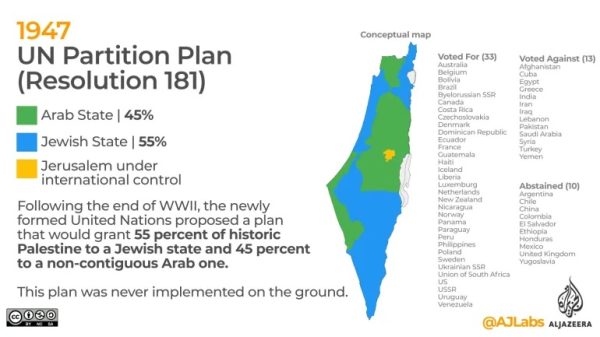
https://www.aljazeera.com/news/2023/11/27/palestine-and-israel-brief-history-maps-and-charts
While from the outside it seems like splitting the city worked, it led to many conflicts. One example of this was the Six-Day War in 1967, during which Israeli forces occupied East Jerusalem and the West Bank. In 1980, Israel declared the annexation of East Jerusalem; however, internationally it is still considered an occupied territory.
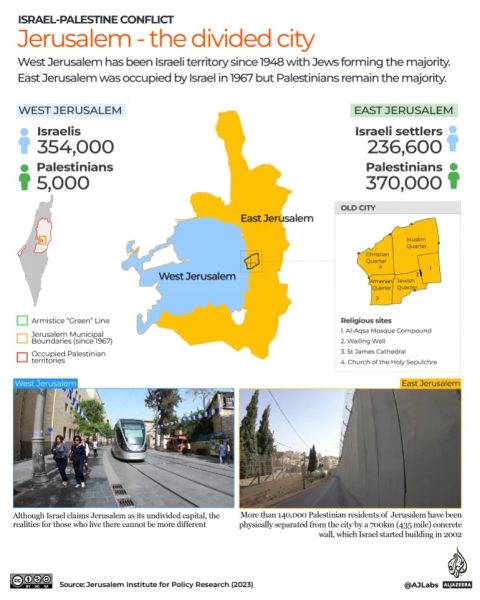
https://www.aljazeera.com/news/2023/11/27/palestine-and-israel-brief-history-maps-and-charts
In 1993 the Oslo Accords were signed by the former Palestinian leader, Yasser Arafat and former Israeli Prime Minister, Yitzhak Rabin. This was the first time the two sides recognized each other and worked together to create peace. In 1995 there was a second agreement signed that split the occupied West Bank into three parts, however, Israel still effectively occupied the area after the agreement.
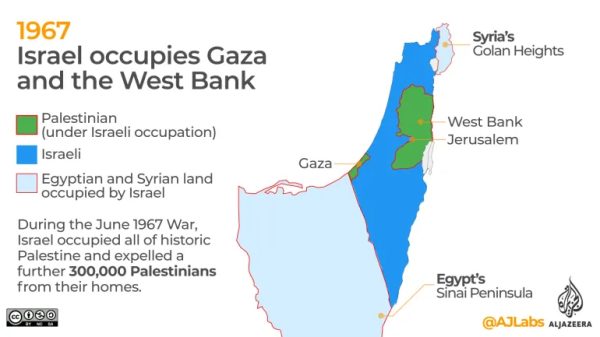
https://www.aljazeera.com/news/2023/11/27/palestine-and-israel-brief-history-maps-and-charts
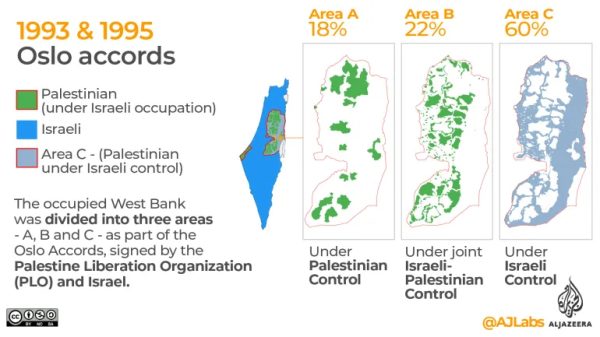
https://www.aljazeera.com/news/2023/11/27/palestine-and-israel-brief-history-maps-and-charts
Due to Israel’s occupation of the West Bank, it has enforced hundreds of checkpoints and physical barriers for people living in the areas. These checkpoints are places where tens of thousands of Palestinians must cross in order to get to work. According to Al Jazeera, most have to leave their homes around four in the morning just to get to work by 7:30. These checkpoints are overcrowded, unsafe and a part of people’s everyday lives. Due to these conditions, it is not uncommon for injuries or even death to occur. An anonymous person at Checkpoint 300 told Al Jazeera, “If you fall to the ground you could die.”
There are at least 645 physical obstacles, 49 consistently staffed checkpoints and 139 occasionally staffed checkpoints in the West Bank. Additionally, in 2022 Israel added an average of four “flying” checkpoints each week to the occupied land. For reference, the West Bank and the occupied parts of East Jerusalem — where these checkpoints and barriers are — is 5,655 km, roughly the size of Delaware, United States and has a population of roughly 2.7 million people.
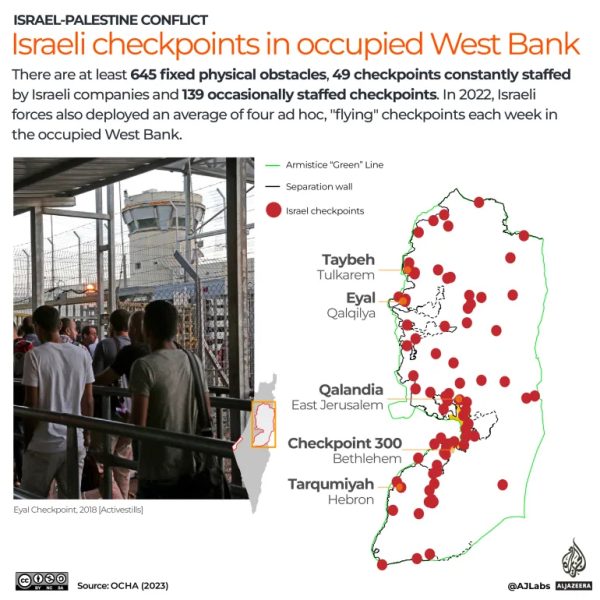
https://www.aljazeera.com/news/2023/11/27/palestine-and-israel-brief-history-maps-and-charts
With this brief background of Palestine and Israel, it is important to note that there is so much more history and complexities. The Middle East is one of the earliest places where people settled and its history is not limited to after colonization. For the purposes of this article, to understand the current war and due to space regulations, I have not included much of the rich history that has formed people, culture and the Middle East. My hope is that this brief history gives one the background knowledge to better understand the rest of the content I will cover in this article.
Looking at the ongoing war in Gaza, it is important to understand Hamas and the current Israeli government. Hamas is a militant Palestinian nationalist and Islamist movement in the West Bank and Gaza Strip with the goal of establishing an independent Islamic state in historical Palestine. The group was created in the late 1970s by members of the Muslim Brotherhood and religious factions of the Palestine Liberation Organization (PLO) and quickly gained a following advocating that Palestine is an Islamic homeland and should never be occupied by non-Muslims.
In 1997, the United States declared Hamas to be a terrorist organization and in 2003 the European Union followed by adding them to its list of terrorist groups. Because of its extreme beliefs, Hamas has promoted the idea that Israel should not be a country, causing many issues for people residing in both Israel and Palestine. The leader of Hamas in the Gaza Strip, Yahya Sinwar, said in a roundtable discussion with young Gazans, “Gone is the time in which Hamas discussed recognition of Israel. The discussion now is about when we will wipe out Israel.”
After defeating its rival political party, Fatah, in 2006, Hamas took control of the Gaza Strip. In 2007, Israel declared that under the rule of Hamas, the area was a “hostile entity” and approved many sanctions that included power cuts, restricted imports and border closures. Since then, Hamas and the Israeli government have been exchanging attacks and countless injuries and deaths of innocent civilians have resulted on both sides.
The current Israeli government is under the rule of the Likud party, which is a right-wing party that holds conservative and nationalist ideologies. Likud was founded in 1973 as a way to challenge the Israel Labour Party which had been in power since its independence in 1948. Some of the values of this party include that they support peace and security, however, they have Zionist beliefs and oppose ceding portions of Israel’s land to Palestinian control.
The current Prime Minister of Israel, Benjamin Netanyahu, has been the longest-serving Prime Minister since Israel’s independence having served three separate times. The first term he served from 1996-1999 during which time he sent mixed messages about his stance on peace and as a far-right politician, many of his actions were met with protests — many of which were not peaceful. He was not re-elected after this. Netanyahu was elected again in 2009 and remained as Prime Minister until 2021. During this term, he continued to lose support from his constituents as protests broke out in Israel over social and economic inequalities. Under his rule, tensions continued to rise between Hamas and air attacks became more frequent on both sides.
After the 2015 election, Netanyahu remained in power, however not by much. Following the election results, Netanyahu was under ongoing investigations on four counts of bribery and other corruption allegations. While serving as Prime Minister, he underwent trial for two of these cases. Due to the Covid-19 pandemic and complications with his trial, Netanyahu remained in power until 2021. His corruption trial continues to unfold and it is unclear what the outcome will be. However, in 2022, Netanyahu managed to re-win the position of Prime Minister and has been serving since.
The current Israeli government holds many Zionist beliefs, meaning they believe that the land of Israel is the homeland of the Jewish people, this also includes land in Palestine. Due to the conflicting beliefs of the Israeli government and Hamas, tensions and war have been happening for years.
With understanding the governments of both Israel and Gaza, it is important to know that attacks on the Gaza Strip, the West Bank and Israel have been occurring for years. So why has it now escalated to a war?
On Oct. 7, 2023, Israel saw its deadliest day since its independence. Hamas launched a surprise attack on 22 locations across Israel, leaving more than 1,200 dead and taking over 130 hostages. The attack was on the Jewish holiday, Shemini Atzeret, and due to the surprise factor, no one was prepared and certainly not for what was to come.
On Oct. 8, 2023, Israel formally declared war on Gaza. The Israeli government cut off supplies, including food and water, to the people of Gaza and soon warned people to evacuate Northern Gaza. However, it was nearly impossible for people to leave Gaza due to the strict security and checkpoints that were already in place by Israel.
Attacks began to hit hospitals in Gaza as people struggled to find a safe place to stay. On Oct. 21, 2023, Egypt reopened the Rafah crossing which became the only non-Israel-controlled way to leave Gaza. Supplies were able to come into Gaza again, however, it was only a fraction of what was being supplied before the war.
By Nov. 6, 2023, the death toll in Gaza reached over 10,000 people, and both sides had taken hostages. In a deal made on Nov. 24, the fighting came to a momentary halt with more than 100 Israeli prisoners and 240 Palestinians released.
In December Israel continued to push attacks further and further south in Gaza, leaving very few options for people to find safety. Other countries began to get involved in the war and the United Nations ordered emergency measures on Jan. 26, 2024. On Feb. 29, 2024, the death toll in Gaza passed 30,000.
Unfortunately, the war seems to have no clear end in sight. Israel forces continue to attack more of the Gaza Strip and more citizens continue to be displaced, injured and killed.
Due to actions that the Israeli government has taken, many living there have lost trust in their democracy and elected officials. In December of 2023, a poll done by The Israel Democracy Institute reported that only 23% of the Jewish public and 19% of the Arab public had trust in their government.
Similar trends have been seen by people living in Gaza with their trust in Hamas. A study done by the Arab Barometer found that 23% of respondents had a “great deal of trust” in Hamas, while 52% had no trust at all.
With hopes of finding an end to the ongoing war, people across the world have been speaking up. Protests across college campuses have become a prominent part of the conversation. While there have been many goals of these protests, one of which is for universities to cut ties with companies and organizations that are funding Israel.
“When people see all these students around the world, uniting, students in higher education, students with some sort of foundation of knowledge, that kind of gives them credibility a little bit,” said Fatima Azouz, a senior at IBW who will be going to Portland State University next year.
Looking back on historical human rights movements, college protests have been at the forefront of these issues. In the 1960s, during the Vietnam War, protests were prominent on many college campuses including Columbia University and Kent State University. During the Civil Rights Movement, people across the country participated in sit-ins and other forms of protest, lots of these demonstrations were held on college campuses.
Columbia University has been home to many protests over the years. The most recent of which started on April 17, 2024. Hundreds of students participated in an encampment protest that started a wave of “Gaza Solidarity Encampments” across the country. In its 14-day stretch, Columbia University had its largest mass arrests on campus since 1968, with 108 students being arrested on April 18, 2024.
Cassidy Beebe, a current senior at IBW, will be attending Columbia University in the fall. Beebe said that while they were initially sympathetic to the protests, the escalation got to an unsafe point. “I’ve lost a little bit of sympathy for basically everyone involved,” said Beebe. “Because it seems like the protests are a little pointless now that it’s causing a lot of problems on campus, but also doesn’t seem to be having really any chance of making an impact, either with the university’s decision making and certainly not any governments.”
One of the major goals of the Columbia University protests was to influence school administrators to cut ties with companies that are funding Israel’s war efforts. At Columbia, this includes Airbnb.
“Whether Columbia divest from Airbnb isn’t going to change anything,” Beebe said. “It’s idealistic college students being tuned into the world. This is probably their first major way of influencing politics. And that’s cool and all but also once you get so far, it’s like occupying buildings, then you’re just sabotaging other people’s, your own education. And that is not going to change anything.”
After Columbia University started the encampment protest movement, many schools were quick to follow. One of which was Portland State University (PSU). On the night of April 25, 2024, a small group of protesters began an encampment on PSU’s South Park Blocks. These protestors also had a goal of sending a message to their school’s administrators about cutting ties with Boeing, a company that has been providing war supplies and funding to Israel.
The following day, school administrators threatened that arrests would be made by the Portland Police Bureau if protests continued. However, the protests did not end, and on April 28, 2024, protesters occupied the university’s library. Barricades were built and property damage soon followed.
Max Niedergang, a senior at IBW who will be attending the University of Puget Sound this fall, has been participating in protests for years. This included multiple pro-Palestine protests at PSU and University of Oregon.
“PSU was very flashy,” Niedergang said. “It was a lot of graffiti, some property destruction and damage, you know, massive barricades got built. And that’s because, in Portland, we are quite used to when a protest happens, the police show up and beat everyone up and arrest people. And we’re prepared for that kind of thing. Part of it is unruly protesters. But a pretty sizable portion of it is unruly police officers.”
Azouz said that she did not attend many protests, however seeing them happen made her feel seen and more safe. “Seeing that so many people who share the same beliefs I have, go to the school, especially because, like obviously I know I’m different,” Azouz said. “I’m a minority and when you go to any school in Oregon, most schools in Oregon, you’re going to be a minority no matter what. So to find that kind of bond, that connecting factor between so many students, I feel it could make me feel much more safe at PSU.”
While some feel supported by the protests, others feel differently. Beebe said, “It was a little bit worrying, you know, I don’t feel great about it [but] I’m not too concerned for my safety.”
The demonstrations that were seen in downtown Portland were not always peaceful. There was damage done to PSU property and multiple arrests were seen. “I feel like the moment they militarized the campus and they brought police to deal with the students protesting, kind of terrified me and made me realize that these schools have no loyalty to their student’s freedom of speech and freedom to believe whatever they want to believe,” Azouz said.
Niedergang also felt that the presence of police at protests leads to feeling unsafe. “The main thing that made me feel unsafe was really the police,” he said. “You know, protesters, even if I disagreed with some of the rhetoric, we were there for each other. We kind of all agreed to have each other’s backs and despite some internal conflict.”
The clash between protesters and school administration is not one to be overlooked. Escalated situations are directly a result of these conflicts. “I feel like the school needs to take a stand and protect their students,” Azouz said. “Especially since these are their students, the schools need to step up and do something about it, if not from police at least from the counter-protesters. And that would give me peace of mind and some security, not a lot but some.”
Property destruction was one of the biggest takeaways from the PSU protests. The PSU library was occupied by protesters for three days and when school officials regained access to the building they estimated that the damage was $750,000.
“There is no tangible way to solve this by killing more people or by harming more people,” Niedergang said. “Now, this is coming from someone who believes that there is a time and a place to, you know, break a window or do you destruction, this just isn’t a solution in this context.”
Ultimately, there is no easy solution for the deep conflicts of the Middle East. There is history that cannot be erased, people whose lives cannot come back and thousands of decisions that have led up to this point. No one quite knows what will happen next or how the War in Gaza will end, but many people are speaking out and raising awareness.
Niedergang said, “There’s nothing complicated about bombs being dropped on civilian targets, but there’s so much complication as to the history of that region and the history of the US involvement, and the separation between governments and the people they claim to represent.”



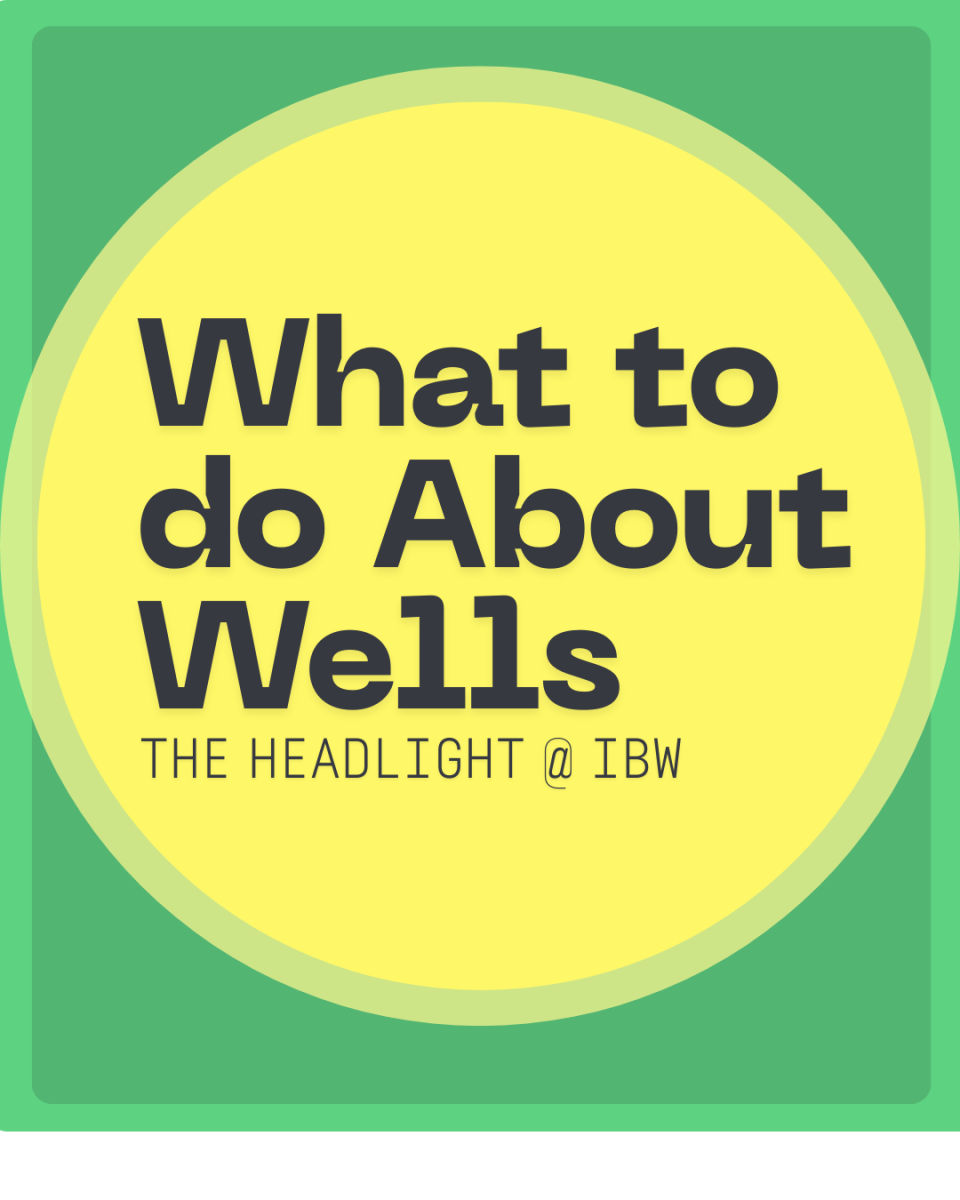

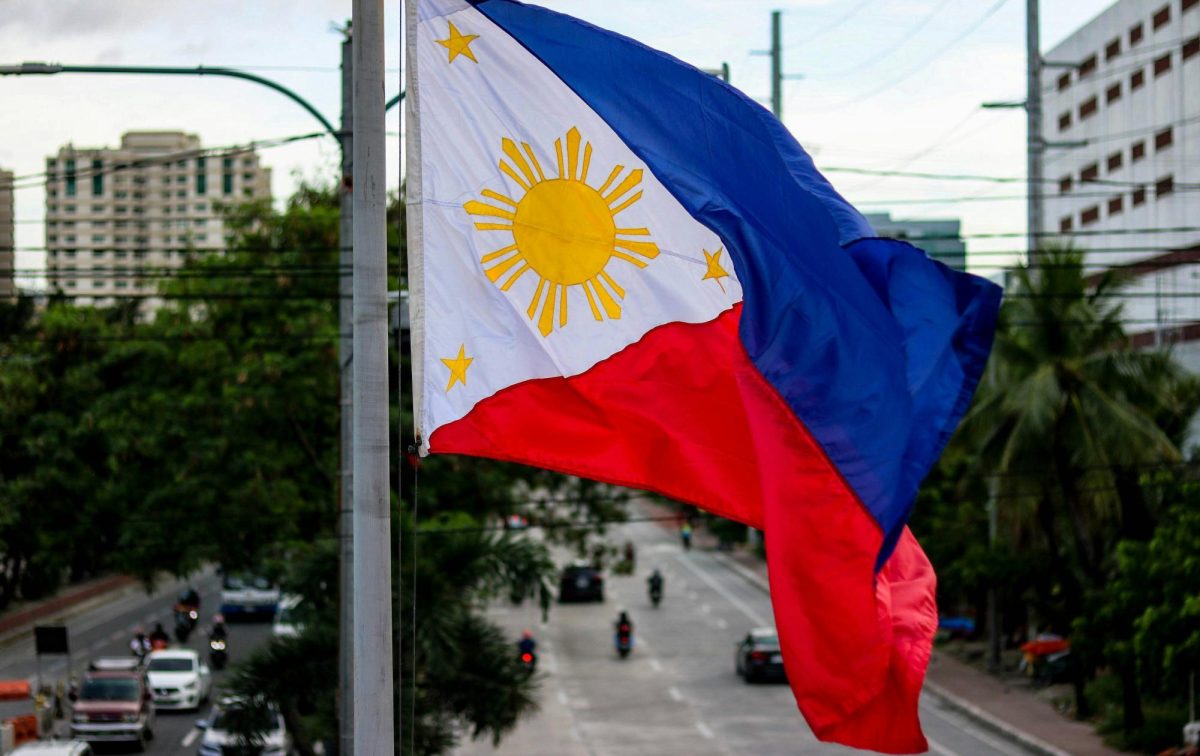
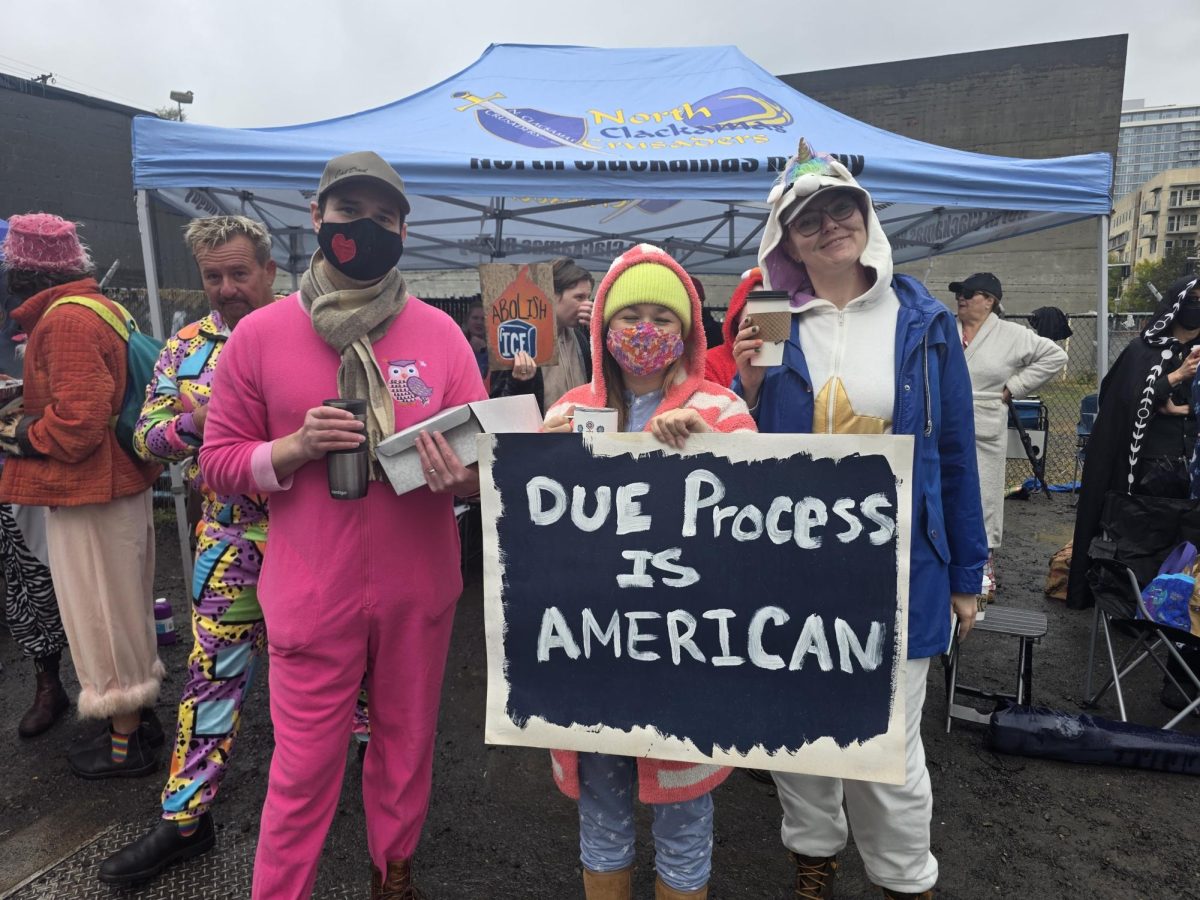


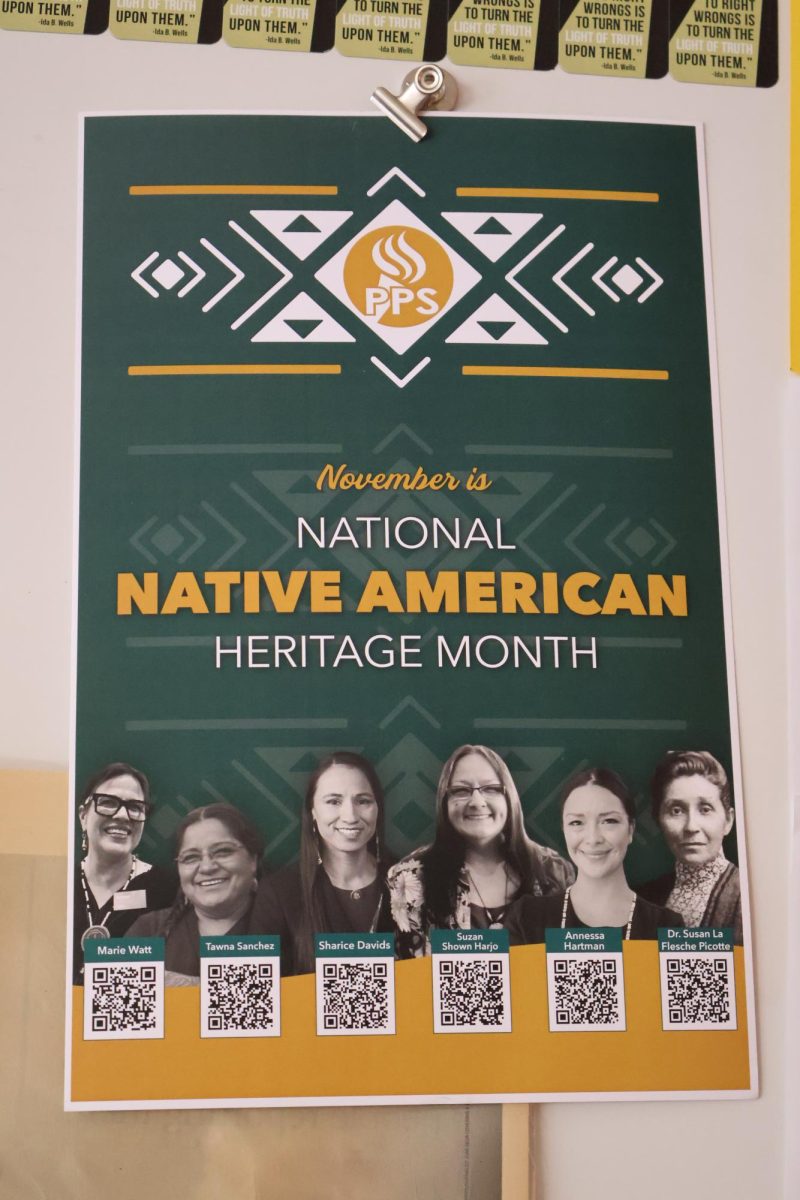
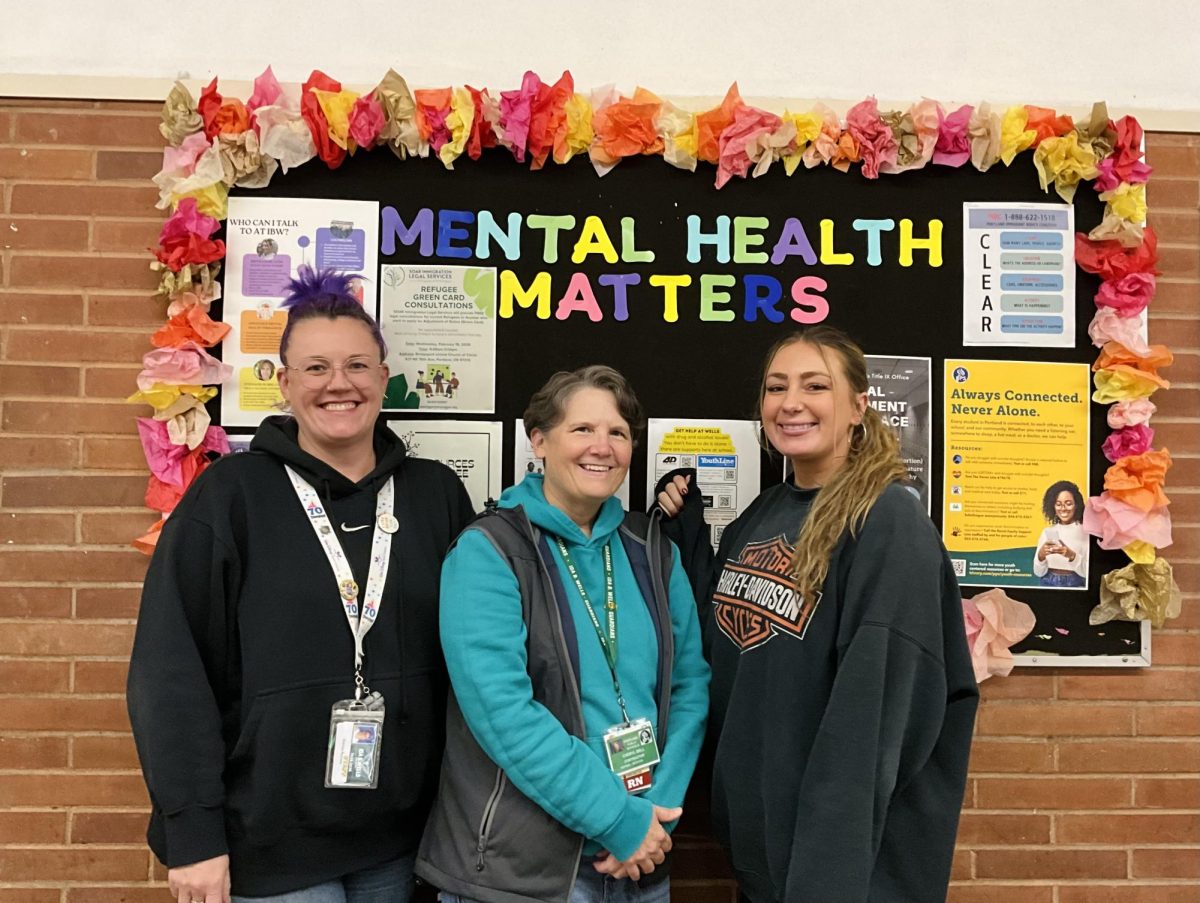

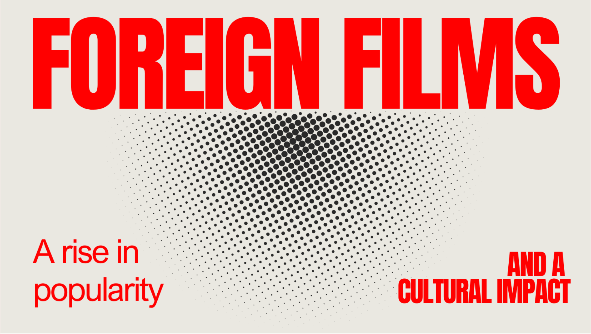
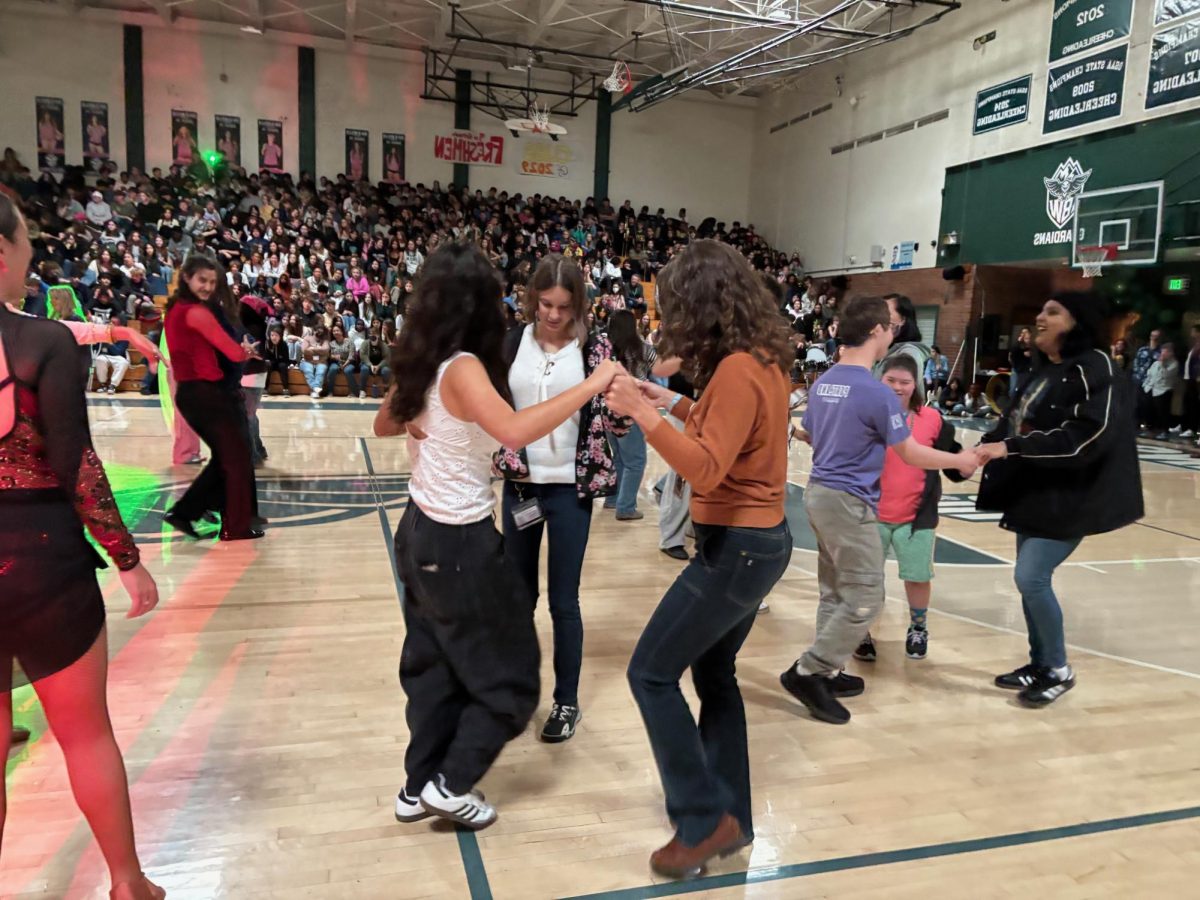


Pierre D. • Apr 10, 2025 at 9:20 am
Impressive writing for a high school senior. Well done Zoe, you have an excellent writing career ahead of you if that’s what you wish to pursue.